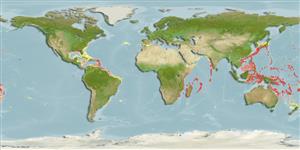Common names from other countries
Classification / Names / Names
Nomes comuns | Sinônimos | Catalog of Fishes (gen., sp.) | ITIS | CoL | WoRMS
Environment: milieu / climate zone / depth range / distribution range
Ecologia
Pelágico(a,os,as); intervalo de profundidade 200 - 677 m (Ref. 116105). Temperate; 75°N - 48°S, 98°W - 175°E
Circumglobal in temperate and tropical epipelagic waters.
Length at first maturity / Tamanho / Peso / Idade
Maturity: Lm ? range ? - ? cm Max length : 1.9 cm BL macho/indeterminado; (Ref. 2255)
Epiplanktonic to mesoplanktonic. Hypersaline specialist (Ref. 116105). Epipelagic (Ref. 116365).
Life cycle and mating behavior
Maturidade | Reprodução | Desova | Ovos | Fecundidade | Larvas
Members of the phylum Chaetognatha are hermaphroditic. Mating behavior: A preliminary visual signaling behavior for species recognition is observed to prevent predation. Life cycle: Eggs directly develop into miniature adults (hatchlings).
Pierrot-Bultz, A.C. and K.C. Chidgey. 1988. (Ref. 2255)
Status na Lista Vermelha da IUCN (Ref. 130435)
Status no CITES (Ref. 108899)
Not Evaluated
Not Evaluated
Uso pelos humanos
| FishSource |
Ferramentas
Mais informação
Nomes comunsSinônimosPredadoresReproduçãoMaturidadeDesovaFecundidadeOvosDesenvolvimento dos ovos
Idade/TamanhoCrescimentoComprimento-pesoComprimento-comprimentoMorfologiaLarvasAbundância
Fontes da internet
Estimates based on models
Preferred temperature
(Ref.
115969): 8.8 - 21.1, mean 14.2 (based on 531 cells).
Vulnerabilidade
Low vulnerability (10 of 100).
Categoria de preço
Unknown.
